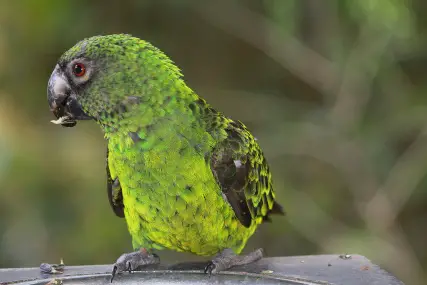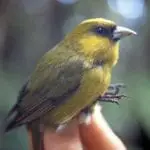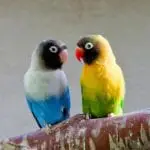Scientific Facts
| Common Name | Jardine’s Parrot |
| Scientific Name | Poicephalus gulielmi |
| Lifespan | Up to 30 Years |
| Size | 10.9 inches (28cm) |
| Body Mass | 7 – 8oz. (220 – 227grams) |
| Habitat | Lowland rainforest, primary Juniperus forest, primary Podocarpus forest, coffee plantations |
| Distribution | Africa |
Information & Physical Appearance
The Jardine’s Parrot is scientifically known as Poicephalus gulielmi.
This medium-sized parrot is classified in the order Psittaciformes, the family Psittacidae, the tribe Psittacini, the genus Poicephalus.
Other common names include Red-fronted Parrot, Congo Red-crowned Parrot, Red-crowned Parrot, and Red-headed Parrot.
There are three races, including the nominate race.
1. P.g. gulielmi – Jardines’s Parrot (nominate race).
The external appearance of adult males and adult females is identical.
The plumage is mostly green. The carpal edge, the thighs, the forecrown, as well as the bend of the wing are characterized with orange/red coloring.
The feathers on the back, wings, neck, and head are black in color, with edges colored in lighter green tones, giving these parrots a scalloped appearance.
The head itself is dark green.
The tail is short, black, and squarish.
The upper mandible is tipped with black, while the base is horn-colored. The lower mandible displays dark grey coloration.
The eyes’ irises are orange/red in color. There is a bare eye-ring in pink/white.
The legs are grey-brown.
2. P.g. fantiensis – Orange-crowned Parrot
Both adults are identical in physical appearance. Fantiensis adults differ from gulielmi adults by the orange coloring on the forecrown and the orange/red coloring on the carpal edge, the thighs, and the bend of the wing.
Also, fantiensis adults are smaller in size than adults in the nominate race.
3. P.g. massaicus – Massai Red-headed Parrot
Adult males and adult females are identical in appearance.
The major difference between gulielmi adults and massaicus adults is that the latter is characterized by less extensive orange/red coloring that covers the area from the forehead to the beak.
Lifespan
In captivity, Jardine’s parrots can live up to 30 years when given the proper care.
In the wild, Jardine’s parrots may live up to 60 years of age.
Ecosystem & Habitat
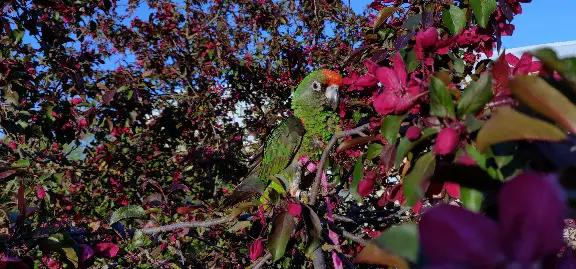
Image Source
Red-fronted parrots are widely distributed across different areas of Africa.
RANGE
1. P.g. gulielmi’s rangespans across the Congo River basin, from northern Angola, southern Cameroon, southeastern Nigeria, and Cabinda to southwestern Uganda and Rwanda.
2. P.g. fantiensis is found in southern Ghana and Liberia.
3. P.g. massaicus’ range encompasses southern Kenya’s and northern Tanzania’s highlands, Mt. Kilimanjaro, Mt. Elgon, and Mt. Meru.
HABITAT
Jardine’s parrots inhabit primary montane forests within their native range.
More specifically, the Red-fronted parrots found in Kenya and Tanzania are found in Podocarpus (a genus of conifers) and Juniperus (trees and shrubs in the Juniperus genus) forest.
The remainder of the range is confined to the lowland rainforest.
While Jardine’s parrots usually occur at elevations of up to 10 660ft. (3250 meters), they are commonly spotted in secondary forest in Ghana and Angola, as well as in coffee plantations.
Food & Diet
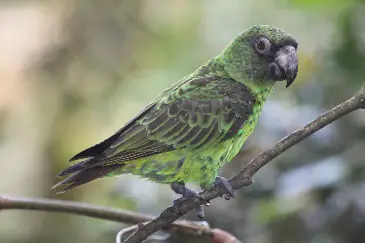
Image Source
Jardine’s parrots are known to feed rather quietly in the wild. They do so in the upper canopy of trees, making it hard to see them while feeding because of being very well-camouflaged.
Usually, they feed in flocks. They also join larger feeding flocks.
In order to reach their favorite feeding sites, they may travel up to 37 miles on a daily basis. These lengthy foraging trips are only taken by Jardine’s parrots living in certain areas of their native range, though.
The wild diet of Red-fronted Parrots consists of seeds, flowers, and fruits, but insects are also taken.
They feed on nuts obtained from Elaeis guineensis (oil palm tree), Grevilleas robusta (southern silky oak)seeds, and Podocarpus flowers and fruits, among others.
Behavior
Jardine’s parrots are known to gather in pairs or in small groups, making noisy calls while they fly between their feeding grounds and night-time roosts. They do so while flying swiftly right above the forest.
In general, they are typically found in small groups that consist of up to 10 birds.
However, where food is abundant, they may gather in significantly larger groups.
Moreover, they will often associate with other birds species at feeding sites, such as Sharpe’s starlings and Rameron pigeons, among others.
Reproduction
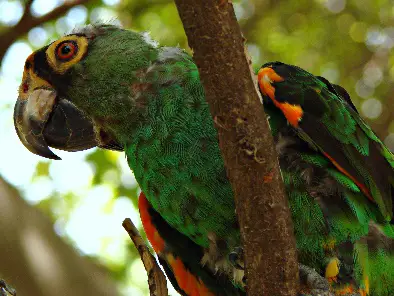
Image Source
In Tanzania, the breeding season for the Red-fronted Parrot typically takes place between November and January.Jardine’s parrots in Kenya usually nest between March and November.
The breeding season in the Congo Basin lasts throughout September.
Like other African parrots, Jardine’s nest in tree cavities. These cavities are usually situated at up to 12 meters (40ft.) above the ground level.
The average clutch consists of 2 – 4 eggs. The eggs are white and glossy. The female incubates the eggs for around 28 days.
Both partners share parental duties when it comes to both feeding and caring for their young.
When the young chicks turn 10 to 11 weeks of age, they are ready to leave the nest.
Survival Threats & Conservation
Poicephalus gulielmi is categorized as Least Concern on the IUCN Red List of Threatened Species.
Due to their vast range, estimating the Jardine’s parrot population in Africa is quite difficult. Even though there is no systematic monitoring scheme, the population trend is estimated to decrease.
One of the major survival threats is none other but trapping for the exotic pet trade.
While red-fronted parrots are listed in Appendix II of CITES (The Convention on the International Trade in Endangered Species), which makes the trade, export, and import of wild-caught individuals illegal, trapping remains a big issue.
Conservation sites are identified over the entire range, yet the species does not occur in any protected areas.
Availability – Where to Get a Jardine’s Parrot
Jardine’s parrots are somewhat common as pets; however, they are not as common as other parrot species.
They are only occasionally bred in captivity. The most commonly available subspecies of Jardine’s parrot in the USA is Poicephalus gulielmi fantiensis.
Note that it often tends to be difficult to find Jardines available for sale, and so patience is crucial. You can acquire a Jardine’s parrot mostly through reputable breeders.
Interesting Facts
Soon after it was scientifically identified, the first Jardine’s parrot was named Congo Jack.
It was Sir William Jardine’s son who brought the first scientifically identified red-fronted parrot from Congo into the United Kingdom. Back then, William R.N. (Sir William’s son) was returning from a cruise that lasted for three years.
Instead of talking, Congo, Jack screamed and whistled but became tame in general.
It was Sir William Jardine to give the species its binomial name. The binomial name was derived from the Latin word “Gulielmi,” which translates into “William’s’); hence the red-fronted parrot was named after Sir William Jardine’s son.
How to Care for the Jardine’s Parrot
1. Housing & Enrichment
Provide a suspended cage or aviary. Make sure the enclosure measures a minimum of 9.8ft. (3 meters) in length.
Note that red-fronted parrots are avid chewers. Providing a variety of bird-safe toys suitable for chewing is a must.
Suitable chewable toys include unsprayed chew toys made out of willow, alder, fir, or pine wood, natural, and/or commercially available sterilized branches, vegetable-tanned leather items.
Swings, ladders, puzzle, and foraging toys are also highly recommended.
2. Diet
Offer a varied, balanced, healthy diet. Do not overfeed your Jardine’s parrot.
Suitable foods include boiled corn or maize, soaked, sprouted or dry sunflower seeds, cooked beans and pulses.
Offer bird-safe fruits on a daily basis, e.g., apples, pears, bananas, pomegranate, oranges, among others.
Offer fresh vegetables daily, too, e.g., celery, fresh corn, green beans in the pod, green peas in the pod, carrots and cooked sweet potatoes.
Complete kibble is crucial, and so is spray millet as a staple in the captive diet.
3. Personality
Jardines are renowned for their high intelligence, as well as for their playful and affectionate nature.
Some individuals are capable of speaking, and they do so very clearly. Also, Jardines are experts at imitating other birds.
Captive-bred red-fronted parrots can bond well, they have an endearing nature, and are not as emotionally needy as other bird companions. But you do need to make sure to keep your Jardine occupied, though!
However, even if left alone for long periods of time, these parrots will rarely encounter emotional stress.
Jardines is family birds, too. While they do have a slight favoring for one member of the family a bit more than to others, they are not “one-person birds.”
Mind that Jardines may become nippy at times. Because of this, training is necessary. Also, considering that these parrots are heavy chewers, training will help to keep your bird from bad habits and destructive behaviors.
Remember that the best way to avoid the establishment of undesirable behavior is to start working with your parrot from an early age.
If you don’t pay enough attention to disciplining your Jardine, your feathery fellow will regard just about anything in the household as a “toy” (even electricity cables), even valuable items that may be especially dear to your heart.
One of the most beloved traits of these parrots is the total absence of clinginess, as well as their rather laid-back nature.
When given plenty of toys and when properly trained, Jardines can spend hours playing on their own. They can make wonderful pets for caregivers with children, and generally require little of your free time.
4. Speech and Sounds
Just like other parrots originating from the African continent, the red-fronted parrot is a good talker.
Jardines may surprise you with their remarkable abilities when it comes to mimicking human speech. They can remember and then repeat phrases very clearly in their distinct voice.
Nonetheless, they are experts at mimicking other parrots.
But apart from their good talking abilities, they are not very noisy. While they do have a loud natural call, they will rarely let you hear it.
Jardines can make excellent pets for apartment dwellers, especially as compared with louder, larger companion birds.
5. Possible Health Issues and Conditions
Jardine’s Parrots are robust and muscular, similarly to their relatives, African Grey parrots.Jardines are capable of thriving in great health, as long as their care requirements are diligently attended by the owners.
Pay special attention to bathing. Bathing time is not only fun and bond-strengthening for the bird and for the owner alike, but it is extremely crucial to these parrots’ well-being and condition.
Regular bathing will help to prevent feather and skin disease. Regular checkups with a qualified avian vet remain a must.
FAQ Section
What Age Does Jardine Parrot Change Color?
Jardine’s parrots change color gradually as they mature. The complete change of colors typically occurs when the bird reaches 4 – 6 years of age, with the pop of red or orange color on the shoulders and forehead finally stopping to grow at this point.
How Much Are Jardine Parrots?
Jardine parrots, also known as Red-fronted parrots, are somewhat common in captivity and only occasionally bred in aviculture. You can expect to pay between $500 – $1200 for a red-fronted parrot pet, with the price range being determined by the person who sells the bird, the age of the bird, its health status, and personality, as well as other unique qualities that vary among individuals.
How Long Do Jardine Parrots Live?
In captivity, Jardine parrots usually live up to 30 years of age. In the wild, though, their average lifespan may actually exceed 60 years.
Do Jardine Parrots Talk?
Yes, Jardine parrots can talk quite well, thanks to their ability to remember and repeat a variety of phrases. Their talking abilities are not as impressive as these of Blue-fronted Amazons; however, Jardines are beloved for their talent in repeating words/phrases in a very clear voice, and can also mimic other animals with spectacular precision.
Are Jardine Parrots Loud?
No, Jardine parrots are not very loud and/or noisy, unlike other parrot species. While Jardines can develop large vocabularies (even without training), and they are expert at mimicking other parrots and animals, they are considered suitable for apartment settings as their naturally loud call will be rarely ever heard.
Are Jardine Parrots Endangered with Extinction?
Yes, Jardine Parrots are endangered species and are protected from the ravages of illegal bird trapping under Appendix II of CITES. They are not considered severely endangered with extinction and are listed under the Least Concern category on the IUCN Red List of Threatened Species.

